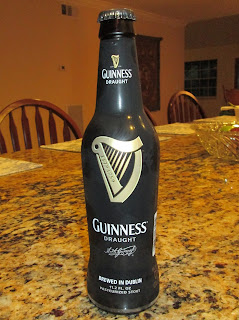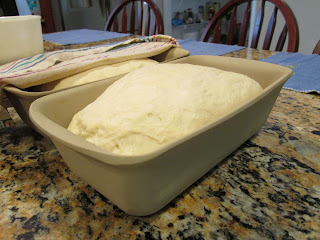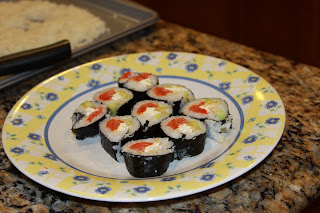For those of you who don't know, the GAPS diet (outlined in Dr. Natasha Campbell-McBride's book,
Gut and Psychology Syndrome) is a diet designed for healing the gut and improving overall health. Since our immunities are located in our digestive tract, it is logical to believe that with better gut health comes better overall well-being.
Since beginning the diet last week,
I have had my ups and downs which include a bit of detox and frustration over planning meals that are not based on wheat and starchy foods. Although I have adopted a more traditional diet over the past few years, I am still struggling with meal planning. I think this diet is even more frustrating because I have one very picky eater (one out of four ain't bad) who has refused to try almost everything I have set in front of her...
There have been some very satisfying accomplishments, as well. My picky eater has tried two new foods that she would normally turn her nose up at, and my youngest son will try (and
enjoy) anything and everything I put in front of him. My own health has also started to improve! I feel less "full" when I wake up, and my sleep has been more restful. I have also had some itchy skin issues, which have started to subside since starting the diet. Although I am experiencing detox symptoms (both emotional and physical), I believe the pros outweigh the cons of continuing with the new menu!
Just a recap of these past few days:
almond flour pizza
Day one:
We tried our first new recipe- pizza, made with almond flour crust. I wanted to start with something familiar so that it would be less traumatizing for the kids. This was a wise decision, and three out of four kids enjoyed the meal, especially when I warmed up some garlic butter to dip the pizza- YUM. This recipe is a keeper.
Although the GAPS book states that bone stocks are good for digestion, I have yet to get any of my kids to try them... I have about 5 gallons of turkey, chicken and beef stock on hand for any takers. I don't relish the flavor, but I can get down a cup at a time (with a little added Celtic salt).
almond flour bread
Day two:
Okay, I went a little crazy with the almond flour today. I found a great website called
Elana's Pantry , which has amazing resources for special diets, including grain-free recipes. I made her almond flour bread (a BIG winner for my "picky eater"), almond flour biscotti, and got countless other recipes to try down the road. A big "thank you" to bloggers like Elana who make my life easier!
I made my first batch of soup today- made with chicken stock, carrots, zucchini, garlic, homemade sour cream and various herbs. I blended it up with my immersion blender (my kids don't like chunky soup) and it was fantastic. I made enough for two meals.
For dinner, we ate fish cutlets with homemade ketchup ( recipes in the GAPS book recipe section) and vegetables. Only two of the kids liked them. Oh well!
almond flour biscotti
Day three:
Made
almond flour pancakes today (another Elana's Pantry recipe), and they were a hit! Good thing, too, because the rest of the day was a flop... I got frustrated with a couple new snack recipes (don't ever say something tastes just like cheesecake if it really doesn't! That was cruel.), and I have vowed to stick to more familiar things in the future. Oh, one more thing... if you've never tried to make "ice cream" from frozen bananas and you don't like bananas, just don't do it. It tastes like bananas- even when you mix it with homemade peanut butter. Really, take my word for it.
I have found that some of my go-to recipes fit the GAPS recipe criteria, so I am trying to stick with familiar items I know my kids will eat. My
French roast chicken is a great choice for my family!
Day four:
I am so glad eggs are on the GAPS menu! Although my kids don't like runny yolks (like the diet recommends), they are more than willing to eat our
chickens' eggs for breakfast, lunch and dinner. I may try adding things to their scrambled eggs, like spinach or tomatoes... We are also lucky to have a butcher shop right down the street that sells fresh pork sausage and bacon! These are staples in our breakfast menu.
The kids are not thrilled with taking probiotics in capsule form, so they are starting every day with a small glass of kombucha, flavored with fruit. I am sticking with a daily probiotic in addition to my regular consumption of kombucha. Probiotic intake is crucial to rebuilding good flora in our guts. I am also trying to get the kids to try fermented veggies, but haven't had much luck- my youngest son will eat the smallest amount of my homemade
kimchi, which is a good start!
We went to a youth group meeting tonight and the kids totally fell of the wagon- I let them decide what to eat, and they all ate at least one or two homemade Christmas cookies. I had a sip of some blueberry cordial, so they weren't the only ones cheating...
I am definitely feeling some detox symptoms today. I feel a bit tired and very,
very irritable! And my face has broken out badly- for the first time in quite a while.
Day 5
I made beef liver pate'. I have always liked pate', but it turns out my kids don't. Another failure!
For dinner, I made white beans (great northern, or navy) and ham in beef broth- my younger two liked them to the point they wanted seconds! I think it helped that I seasoned them with a small sprinkling of Cajun spices. My older son ate it, but didn't care for it... my picky eater said she wasn't hungry.
I am feeling a bit better today. Detox symptoms have started to subside, and I have more energy. It will take a while for my face to clear up, but no new blemishes!
I am determined to stick with the diet for as long as I can. My kids may or may not follow my lead. It will be a long journey but hopefully worth the effort. :) Since I will be on this diet long-term, I will not be updating daily, but my posts will reflect my new diet. I am excited about learning new recipes and sharing them with you! Enjoy!




















































